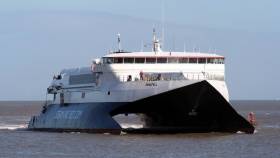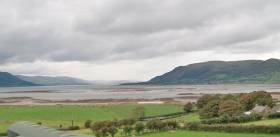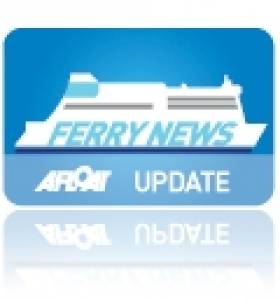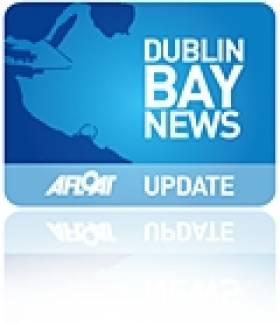Displaying items by tag: ferry
Campaign to Restore UK Ferry From Fleetwood to Isle of Man
#RouteCampaign - A campaign has been launched writes IOM Today to revive an Irish Sea ferry link between Fleetwood, Lancashire and the Isle of Man.
Fleetwood Weekly News has reported that a petition has been set up by Manx businessman Steve England which has gathered 1,630 signatures.
A Facebook campaign group (which Afloat adds, refers to Steam Packet's recent berthing trials at Holyhead) has also been set up to support the (Fleetwood) move and has attracted 9,237 members.
There are currently questions over the future of passenger ferry sailings between the island and Liverpool with plans to move the Steam Packet’s landing stage from Albert Dock to Waterloo Dock, half a mile away.
Port bosses the Peel Group are in discussions with the Isle of Man government over the £15m plans, which could see work start on the Waterloo Dock site in around 12 months time.
For more on this story, click this link.
Legal Challenge Against Carlingford Ferry Terminal Plans
#FerryNews - A new car ferry route that aims to cut the distance between towns on opposite sides of Carlingford Lough from 32 miles to just one is facing a legal challenge from campaigners opposed to the building of a new terminal.
As previously reported on Afloat.ie, the ferry route across the narrowest part of the lough between Greencastle, Co Down and Greenore, Co Louth was given the go-ahead last summer despite the objections of local residents who argue that the project would "spoil the natural beauty" of the area.
According to the Belfast Telegraph, activists have now lodged papers in Belfast High Court requesting a judicial review against Newry, Mourne and Down District Council.
Among their claims is that permission to allow for piledriving in the lough's north shore for pontoons for the £7 million (€8.9 million) scheme was not properly given.
The Belfast Telegraph has more on the story HERE.
Irish Ferries Recognition of 20 Years Service At Roscoff
As part of celebrations to mark the 20th anniversary of Irish Ferries' services from Rosslare to the French port of Roscoff, a civic reception – attended by the mayor of Roscoff Mr. Joseph Seité and other local dignitaries, chamber of commerce officials, commercial, maritime and tourism representatives from the French region and members of Irish Ferries’ management – was held on board the company’s vessel Oscar Wilde.
During the course of the event, Irish Ferries was praised for the contribution that it makes in promoting tourism and trade in Roscoff and throughout the wider Brittany region and for the investment it has made over the course of two decades, both at sea and ashore.
Pictured at the event is Irish Ferries Managing Director Andrew Sheen, Captain Steven O’Mara and Ole Bockmann who, since the early days of direct car ferry services between Ireland and France, has been director of operations for Irish Ferries at the ports of Cherbourg and Roscoff.
#dlharbour – Hostile questions were asked in the Dail on Wednesday by local TD Richard Boyd Barrett on the proposed development of Dun Laoghaire Harbour as a cruise liner port. They were deflected in ministerial replies about legislation currently being drafted, and the two possible viable ways forward for the harbour's administration. But the underlying pace is accelerating towards a resolution of the future of this unique example of Victorian design, engineering and construction. W M Nixon finds that, in recent days and weeks, his views on the possible uses of this magnificent artificial harbour have undergone considerable change.
Embarrassment is a powerful stimulant for change. Change of attitude, change in ways in behaving, change in ways of looking at things, change to entrenched ways of thinking. I was hugely embarrassed by something seen in Dun Laoghaire nine days ago. And within seconds, there came a complete epiphany, with the sudden awareness that an entrenched attitude towards the development of Dun Laoghaire as a cruise liner port had turned through about 140 degrees.
It made for the complete 180 degrees, as the first 40 degrees of the turn had already been achieved a couple of weeks previously, while spending two completely absorbing if mentally exhausting hours with the maverick Alistair Rumball and his team at the Irish National Sailing School beside the inner recesses of Dun Laoghaire's inner harbour, which is still called the Coal Harbour even though it's very many years since anyone offloaded any lumps of the black gold there.
Be that as it may, as we parted we were shooting the breeze about the proposed development of Dun Laoghaire as a cruise liner port, which has been top of the local agenda since the end of March, and handily gave us one of our choicer April Fool's Day stories here on Afloat.ie - it proved so effective we had to add a health warning.
When a story provides you with something like that, you develop a certain affection for it. So while Alistair and I agreed that that the absolute dream solution for Dun Laoghaire Harbour would be a top-of-the-line government-funded National Monument Preservation Scheme, with the entire place given over exclusively to recreation afloat and ashore, and no commercial shipping of any significant size whatsoever allowed about the place, we knew it was pie in the sky.
"How on earth would they really pay for it?" he asked. "This place is huge, it costs a fortune to run and maintain. A cruise liner berth offers the best and most compact method of providing a worthwhile income stream. And as we in our sailing school – being a commercial operation – have to be rigorous in observing harbour regulations and keeping clear of the established in-harbour shipping lanes, we know that you can continue to sail small boats in large areas of the harbour without any undue sense of space restrictions".
Subsequently, I've been spending some time around Cork Harbour, where circumstances are so different from Dublin Bay that, unlikely as it may seem, you end up feeling sorry for the sailors of south Dublin. For while Cork is almost embarrassed by its riches in natural amenities for sailing, and it's all in a large and attractive harbour where marinas can be put down almost anywhere with no more than a floating breakwater to provide the necessary minimum of shelter, Dublin Bay by contrast is a hugely deprived area in terms of natural waterfront facilities for sailing, yet any attempts to provide man-made shoreline amenities for boats and sailors are dogged with local opposition every inch of the way.

Around Cork Harbour, it only needs a floating breakwater and, hey presto, you've suddenly got a marina - as seen here at Monkstown. Photo: W M Nixon
Thoughts of this struggle, and how things change, emerged again for various reasons in Dun Laoghaire nine days ago, at the reception in Irish Lights HQ to launch the Great Lighthouses Tourism Initiative. Time was when our many fine lighthouses were places of mystery, and permission to visit took quite a bit of arranging if it could be managed at all. But my word, times have changed. In this electronic age, there are those who wonder if we need all our lighthouses. Yet Irish Lights is legally obliged to maintain them, and the built structures around them.
So Yvonne Shields, the CEO of Irish Lights, whom we'd describe as very switched on and extremely bright were we not talking of the top executive in a lights organisation, unveiled this sensible scheme whereby twelve of our greatest lighthouses are being transformed into stations on a tourist trail, while continuing as working lighthouses.
As the greatest and most monumental lighthouses on land tend to be on rugged headlands in remote areas, in the eyes of Brussels they're in peripheral areas deserving special aid. So there's €2 million of Eurodosh going into this project, which sees what had become increasing liabilities being transformed into tourist resources. And if we're going to be sniffy about that, let's face it: the kind of tourist who'll want to visit a remote lighthouse will not be the kind of tourist who would keep you well clear of Temple Bar.
So the old grey matter was churning briskly away on the business of seeing lighthouses in a new way as we headed home past the Coal Harbour, and there it was: The Embarrassment. For this was the evening at the end of the day when the majestic and rather handsome cruise liner Queen Mary 2 was anchored off Dun Laoghaire in a near gale from the southwest which had delayed the morning's arrangements to ferry passengers ashore in the ship's own tenders to the special landing pontoon installed by the Harbour Company in the inner harbour.
By this time, they were trying to return on board, waiting patiently in a queue which ran the length of the inner pier and more as the two ship's tenders bustled the mile and a half plus out to the ship, yet still more buses turned up to disgorge more passengers, such that for a while the long length of the queue seemed to stay persistently the same.
Perhaps it's because we Irish don't do queuing that I found the entire thing acutely embarrassing to behold. And it wasn't even as if it was raining, which it well could have been. Nevertheless it struck me as being a Third World sort of scenario. Yet obviously these people were keen to visit Dun Laoghaire – most of the thousands of passengers on board had elected to go ashore.

This just won't do at all – images of Third World destinations came to mind on seeing the passengers from the Queen Mary 3 queuing in the Coal Harbour in Dun Laoghaire to get back out to their ship anchored in the bay. Photo: W M Nixon
So the epiphany came with the essential flashing great light. If we're going to have cruise liners calling at Dun Laoghaire, boomed this disembodied voice, then let's do it properly and provide them with a proper berth. Otherwise, don't have them about the place at all. But please, please – no more buzzing in and out in little tenders in this Irish climate, and no more queuing on a comfortless pier. It's an affront to our best traditions of hospitality.
This sudden firing-up with all the zeal of the recent convert (for until then, I'd wanted Dun Laoghaire to stay exactly as it is, and damn the expense) resulted in my being right into the dragon's den four days later. It was meant to be a short and businesslike meeting with Gerry Dunne, the CEO of Dun Laoghaire Harbour Company, to discuss the Cruise Liner Berth Proposals. But so many ideas were flying around that we ran well over time.
Please be assured, though, that I did my best to represent the needs of the boat-owning and sailing community while accepting that since Stena Sealink withdrew from running a ferry service from Dun Laoghaire to Holyhead, something very serious indeed needs to be done to pay for the maintenance of the harbour.
We have to remember that, among Ireland's main sailing centres, Cork and Kinsale are blessed with such good natural harbours that any marinas located in either harbour do not need fixed breakwaters. As for Bangor Marina on Belfast Lough, it may need a very substantial solid breakwater on its north side, but otherwise - thanks to being located in a bay - three of its four sides are naturally sheltered. But Dun Laoghaire is badly done by – it's so totally an artificial harbour in an exposed location that three of its four sides are protected by large man-made breakwaters, and while they are constructed in monumental style, continuous monitoring and maintenance is essential.
This is costly, but it would become even more so were standards allowed to slip for even a year or two. Even with the present high standards, there can be underlying wear and tear which in time needs major capital expenditure, and according to one recent report, hidden erosion on the most exposed section of the East Pier may eventually need up to €5 million for a proper remedial job.
As it is, the current basic running costs of the harbour are between €2 and €2.5 million a year. Were it kept as a purely recreational harbour and general public amenity, this figure could perhaps be slightly reduced. Yet the Dun Laoghaire recreational boating market still could not withstand paying the full amount out of its own resources and expected annual expenditure, so the shortfall would have to be made up by Government subvention.
But would the sailing and boating people of Dun Laoghaire really like to feel that they're beholden to taxpayers throughout Ireland for their continuing enjoyment of this wonderful amenity at affordable prices? There's something unpleasantly artificial about the idea of such an arrangement, whereas a harbour which is providing a modest but genuine profit is something which has a much healthier feel to it.
Surely if a way can be found of generating a worthwhile income stream without unduly distorting the traditional functioning of the harbour, then that idea should at the very least be actively explored, and recreational boating groups should be prepared to reach out towards compromises in the knowledge that, in turn, such arrangements would make the Harbour Company more accountable to all.
However, local representative Richard Boyd Barrett TD of the People Before Profit party, and Chair of Dun Laoghaire Save Our Seafront Group, sees it differently, and he has called for "a major campaign of people power against the planned cruise berth, and to protect the future of the harbour as a public amenity". His three main objections to a cruise berth plan are "(1) That the cost and financing of the project at €18 million means that the Harbour Company will have to borrow using its existing assets, where no proper business case has been produced. This puts the very future of the harbour at risk. (2) The entire plan has been hatched by an unelected board of the Harbour Company, Council Executives, and local business people who ran a sham of a public consultation over the two weeks of the Easter Holidays, and (3) The scale of the luxury liners at 300 metres long and 59 metres high will dwarf the harbour and reduce public access and public enjoyment of the most intact Victorian harbour in Britain and Ireland".
So with a Harbour Company which is government-owned, yet is charged with maximizing the economic benefit and exploiting the commercial opportunities provided by Dun Laoghaire Harbour, clearly there is something of a divide between the two sides. In fact, "light years apart" just about sums it up.
Nevertheless, politics being the art of the possible, it has to be possible to bring people together sufficiently to see that perhaps a proper sympathetically-designed cruise liner berth might indeed be the answer. After all, although it was built between 1817 and 1842 purely as a harbour of refuge for sailing ships with no thought of any interaction between sea and land, it very quickly became a ferry port for cross-channel steamships. At the height of this activity, with frequent roll-on roll-off ferries and their unpleasant shoreside traffic dominating the waterfront, Dun Laoghaire had lost much of its charm.
For the life of me I can't see that the much more limited shoreside traffic generated by the visits of cruise liners in the summer months can be seen as being anything like as obnoxious as the previous waves of road and rail traffic for the ferries, which was readily tolerated, and helped to keep the place going for 180 years.
And in any case, with the end of the ferry services, Dun Laoghaire definitely lacks purpose. In the Irish climate, it is very difficult to maintain a sense of vitality around a harbour which is purely devoted to personal recreation, whether afloat and ashore. It could be argued that, regardless of the economic benefits, it would be good for the mental spirit and communal well-being of Dun Laoghaire to be a cruise liner port of call, as a cruise liner strikes a neat balance between work and play. Like it or not, all work and no play may make Jack a dull boy, but all play and no work makes him mad.
But even if we accept that the shoreside traffic will be much less than it was with the regular ferries even if there is a cruise liner in port every other day, that is only part of the equation. How does the town itself shape up as a desirable cruise liner destination?
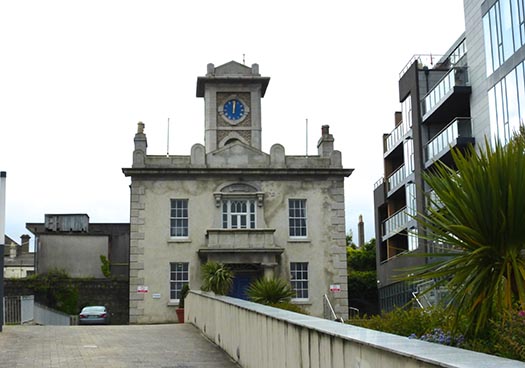
The Harbour Lodge is symbolic of today's Dun Laoghaire, a classical building from an earlier age, but now enclosed by modernity. Photo: W M Nixon
When we get down to the nitty gritty like this, Gerry Dunne is in his element. He's an affable guy, and good company, but I wouldn't like to get into a row with him, as there's steel underneath it all. So in the sedate setting of Harbour Lodge – which he cheerfully admits his opponents and friends have nick-named "Mussolini's Palace" – he's just the man to fight off the brickbats and work his way towards several objectives. But although he actually lives in Dun Laoghaire within walking distance of his office, he's not really into boat and water sports, yet that's no drawback, as personal preferences definitely don't come into it at all as he plans the way ahead.
He makes no bones about admitting that his attitude is strongly commercial. Before taking over the reins at Dun Laoghaire Harbour Company, he was Commercial Director at RTE, a job description which boggles the mind. Before that, he honed his skills in the UK, working for several large Irish food companies. If that gives you a vision of ditzy little artisan cheeses selling in agreeable country shops, then perish the thought – the big Irish food industries provide as tough a business environment as you could imagine.

The many moods of Gerry Dunne.Toughened by a varied and demanding career in business and marketing, he has brought a fresh mind to the problems of making Dun Laoghaire harbour economically viable. Photos: W M Nixon
He joined the Harbour Company in 2009, when talk of Stena's withdrawal was already in the wind. So he got Dun Laoghaire moving towards the cruise liner market in a small way, with the miniature 53-passenger Quest in 2011. Finding Quest an in-harbour berth was no problem, and she provided invaluable information on what Dun Laoghaire can provide as a USP for discerning cruise liner passengers. For Quest's rather specialist group, it was the easy access to the Wicklow Hills and particularly Mount Ussher Gardens, and they definitely didn't want to have to travel through Dublin City to get there.

The mini liner Quest – seen here in the Arctic - began the programme of attracting cruise ships to Dun Laoghaire in 2011
So far so good, but Gerry Dunne really struck gold when he started going to the cruise liner fairs in America and Europe. Gradually he built up a useful network, and again he struck gold when he got a report on the potential attractions of Dun Laoghaire from the Vice President (Itineraries) of one of the biggest American cruise liner conglomerates. Asked to sum up in one word the attraction of the Dun Laoghaire for visitors coming in from sea, her answer was: "Serenity".
We've become accustomed to Venice being talked of as The Most Serene Republic - The Serenissima. But it makes you sit up and take notice to hear of Dun Laoghaire being so described by a tough American businesswoman. Yet that's the impression the waterfront area, with its combination of the old yacht clubs, the station, the Town Hall and the Royal Marine Hotel, apparently makes on seaborn visitors from cruise liners, even if their liners are at present anchored outside the harbour and they have to be ferried in to land by ship's tenders. It seems they can blank out the less attractive buildings, and are left with the abiding impression of relaxed elegance with an easygoing way of life.
This takes a bit of getting used to, as it's so much at variance with the perception in Ireland of Dun Laoghaire as a place where they'd argue over anything and everything all the time, while just up the street there's the real problem of the dreary array of boarded-up shops. But like it or lump it, here it is folks – the reality is the yacht clubs and other other historically significant and stylish buildings of the Dun Laoghaire waterfront area – including the pleasantly under-stated Victorian residential terraces - are the town's greatest tourist asset.
Quite what some of the more senior members of the yacht clubs will make of that we can only guess, but the word is that the clubs have indicated that they'll be prepared to welcome some cruiser liner guests to their premises at pre-arranged times. So perhaps we should see the cruise liners as no more than extra-super super yachts......And there's no doubt that many rugged sailing folk from Dun Laoghaire are themselves only too happy to tootle off on a cruise liner when the peak of the sailing season is over.
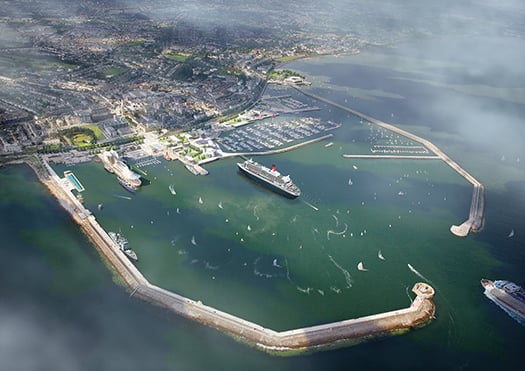
The artist's impression was just that – an artist's impression. If the new berth goes ahead, cruise liners will actually have their sterns towards the town.
But what is the reality if the new berth is agreed? Well, you can forget about your artist's impressions showing a liner facing the town. Space will be restricted, so the liners will come in stern first, thereby enabling them to make an elegant departure for the benefit of crowds down the end of the piers, which could become a popular occurrence.
The new liner pier will be as short as possible, though it will have an underpass for small craft, while the bows of the ships themselves will be held in place by dolphins, as was the HSS ferry. If you think that getting into this berth will involve impossibly ticklish manoeuvring, consider this recent photo of the three Cunard Queens up close and friendly in Southampton, and note that there's no lack of small craft nipping about among them.
 The three Cunarders can manoeuvre unaided at close quarters even with several small craft nipping about their heels, as seen here in Southampton
The three Cunarders can manoeuvre unaided at close quarters even with several small craft nipping about their heels, as seen here in Southampton
One of the other drawbacks about the current setup, with the ships anchoring off and people disembarking in the Coal Harbour, is that there's very little space for buses to move about, but the present waterfront marshalling yard left behind by the exit of Sealink will greatly relieve that problem if the new berth is built. At the moment, it is planned that passengers will walk the short length of the pier to reach their buses, but my own feeling is that the pier should be made a bit wider with a turning circle in order that passengers may board their buses almost directly from the ship, for we're not talking long distance athletes here.
That said, those who are fitter can come and go as they please, with the town within easy reach, whereas being anchored off can cause cabin fever. In other words, if Dun Laoghaire is going to have a cruise liner berth, let it be done properly – half measures involving long walks to buses just won't do, but equally for those who do walk, the town must feel accessible and welcoming.
As to the amount of space the ship will take up in the harbour, that will vary from ship to ship, but some are indeed enormous. And their wind-deflecting presence will certainly add an extra interest to in-harbour dinghy racing. As for the interest of the in-harbour racing for the visitors on the ship, that in turn will all be part of Dun Laoghaire's colourful charm, for which their ship will provide a grandstand view.
In line with that, we should remember that the leading in-harbour class, the historic Water Wags, have only just returned from showing themselves off at Morbihan Sailing week in France. Thus they'll scarcely be unduly bothered about providing a source of fascination for passengers on cruise liners, some of whom will probably be former dinghy racers themselves.

The Water Wags find it easy to sail freely within Dun Laoghaire Marina on their way out to race in the main harbour, so their only problem with a cruise liner berthed in mid-harbour will be the effect it has on wind flow. Photo: W M Nixon
But what the in-harbour dinghy racers are already becoming happily accustomed to is the newly-emptied eastern half of the harbour, with space now provided where boats used to moor. And this area will not be at risk from maneuvering cruise liners – there's not the depth for them. Finally, as to the height or otherwise of the ships in relation to other structures in Dun Laoghaire, I think we've been righteously indignant about this on a mistaken premise – since the new library was pushed into place, all bets about skyline heights and an elegant relationship with other waterfront buildings are clearly off.
So if the sailing and boating community can be more accepting of the cruise liners which will ultimately provide a real source of income to maintain the harbour which makes their activities possible, what can they expect in return?
They're in a strong negotiating position. After all, the Harbour Company's research has shown it is the comfortable presence of the yacht clubs which underpins this vision of serenity which is Dun Laoghaire's most appealing attraction for the kind of people who enjoy the cruise liner experience. So it's very much in the Harbour Company's interest to keep the clubs in good health.
By today's standards, the Royal Irish YC is thriving, thanks in no small part to its location within the marina against whose creation, ironically, the club fought tooth and nail. But the other three clubs – the Royal St George, the National, and the Dun Laoghaire MYC – are blighted by the limited and relatively unsheltered pontoon berthing at their clubhouses.
It may well be – and I'm only guessing – that the Marina Company's agreement with the Harbour Company includes a clause that these three clubs are not allowed to have their own adjacent marinas. But if such a clause exists, then it should be deleted for the greater good of the harbour and the vitality of the waterfront in general, and the three clubs should be facilitated in providing 150-boat marinas – with proper breakwaters for the George and National - in front of each clubhouse.

Dun Laoghaire from the southeast. If the new cruise liner berth is installed at mid-harbour, a longterm plan could be the installation of breakwaters in front of the Royal St George YC and the National YC in the foreground to shelter two new 150-boat marinas, as the location of the Royal Irish YC within the main marina gives it an unfair advantage in providing facilities for its members.
As to how Dun Laoghaire town can benefit, that's another matter altogether. The much stronger income and improved employment going through the Harbour Company will undoubtedly be a tangible good, though how seasonal it will be – with liners expected only between April and October – remains to be seen.
But personal expenditure by cruise liner passengers in the town is an imponderable. In fact, some cruise liners in the popular sunshine destinations are notorious for disembarking guests who feel that they made their total investment with the purchase of the ticket back home, so they don't plan to spend any more.
The historic little Venetian city-port of Dubrovnik on the Adriatic – which doesn't have a proper liner port – recently banned cruise liners from coming anywhere near the place, as their thousands of passengers made the narrow streets very uncomfortably crammed at peak times, yet the average expenditure ashore in Dubrovnik by each cruise liner passenger was precisely €6. There's food for thought. But we will of course get a better class of cruise liner passenger in Dun Laoghaire...
Search For Passenger 'Missing' From Irish Sea Ferry
#Missing - RNLI lifeboats from Bangor and Donaghadee joined the search early yesterday morning (Tuesday 19 May) for a passenger feared to have gone overboard from an Irish Sea ferry in Belfast Lough.
As BBC News reports, it's believed a man from Manchester went missing from the Stena Mersey overnight ferry from Birkenhead to Belfast.
Reports have it that he was last seen overnight as the ferry crossed the Irish Sea, and the search was divided between inner Belfast Lough and from the Copeland Islands into the sea long the ferry route.
New Managing Director of Irish Ferries
#irishferries – Irish Continental Group (ICG) has appointed Andrew Sheen to the position of Managing Director of its Irish Ferries division.
Andrew will assume his new role with effect from the beginning of April, reporting to ICG's CEO, Eamonn Rothwell.
Operations Director since 2012, Andrew has been involved in shipping for over twenty-six years, ten of them with Irish Ferries - first as a sea-going Chief Engineer and, since 2010, in shore-based operations roles.
A Chartered Engineer and Fellow of the Institute of Marine Engineers, he holds a BEng (Hons) degree in Mechanical and Marine Engineering and an MSc in Marine and Offshore Engineering.
Previous appointments include roles in marine consultancy and Engineer Surveyor and Technical Performance Manager positions with the UK Maritime & Coastguard Agency.
Wishing Andrew every success in his future role, Mr. Rothwell said "Andrew has impressed us all with his strong skills in the ship operational area along with his undoubted drive and enthusiasm in developing Irish Ferries."
What Next For Dun Laoghaire After Stena Departure?
#DunLaoghaire - With the end of Stena's ferry service between Dun Laoghaire and Holyhead confirmed earlier this week, The Irish Times' Lorna Siggins gauges the mood in the south Dublin port that aims to transition from a commercial focus to a more diverse leisure hub.
Described as "the worst-kept secret on this coastline" by harbour user and dinghy sail trainer Alistair Rumball, Stena's decision to pull out of Dun Laoghaire is being seen as good news for the harbour company's master plan, with its emphasis on enticing cruise traffic, tourism and related facilities.
Among these are the planned diaspora centre, and the 'urban beach' project for the East Pier that was green-lit by planners late last year but is currently under appeal.
However, local TD Richard Boyd-Barrett argues that the move only opens the way for "back-door privatisation” of the harbour. And even our own WM Nixon wondered earlier this year about the scale of the master plan's ambition, and whether Dun Laoghaire has lost the plot.
The Irish Times has much more on the story HERE.
New Ferry Port Manager Announced at Portsmouth International Port
#portsmouth – Portsmouth International Port on the UK south coast has a new Ferry Port Manager, although the man now in charge of all ferry operations certainly isn't a new face at the Port.
Kalvin Baugh joined the team at Portsmouth in 2008 as Deputy Ferry Port Manager. His promotion comes after seven years of hard work, and is at a challenging time for the ferry industry given the current economic climate and the continued environmental challenges.
Kalvin was born and grew up near Cardigan, West Wales. After leaving school aged 18 he joined Cunard as an Engineer Cadet. The apprenticeship led to a role as Engineering Officer four years later.
In 1985 Kalvin moved to Portsmouth, taking a job with the Ministry of Defence at HM Naval Base. Five years later he went back to sea, working for companies such as Geest, Nissan, and Thames Water. In 1994 Kalvin started work for United Marine Dredging, part of the TARMAC Group and spent 15 years as the company's Marine Operations Manager based in Chichester.
Kalvin says, "There's never a dull moment working at Portsmouth International Port. No two days are ever the same for me. My main aim is to help to ensure we always provide an excellent service for passengers and operators, whatever challenges we face."
Dun Laoghaire Harbour Seeks Seasonal Ferry Service Operator from Dun Laoghaire to Holyhead
#stenaoutofdunlaoghaire – Following the news that Stena has decided not to resume its Dun Laoghaire Harbour Seasonal Ferry Service. Dun Laoghaire Harbour Company Ltd (DLHC) is seeking expressions of Interest are now being sought by the Dun Laoghaire Harbour Company from suitable providers to operate a seasonal ferry service on the Dun Laoghaire to Holyhead route.
A ferry service has been running between Dun Laoghaire and Holyhead for over 170 years (since 1835). A small fast craft was introduced to the route in 1993 which was replaced by the world's largest fast craft, the HSS, in 1995. Stena Line, the operator of the ferry service, decided not to resume service on this route this week. As a result, a berth has become available in Dun Laoghaire for a new ferry service.
The full advert for the new operator is here
Greek Fire Ferry Cable Snaps, Killing Two
#NormanAtlantic - A cable used to tow the blaze-damaged Mediterranean ferry Norman Atlantic has snapped, killing two Albanian crewmen, the Daily Telegraph reports.
The incident is the latest in a series of tragedies since fire engulfed the lower decks of the Italian-registered vessel on Sunday 28 December.
As of last night the death toll had risen to 10, reports the Irish Examiner, with officials yet to confirm any people missing from the 478-name passenger manifest.
Some of the 427 people rescued in a difficult operation amid poor weather conditions are not listed on the manifest, suggesting they may have been travelling illegally.
The Guardian has an account from one passenger, British show-jumper Nick Channing-Williams, who described how his fiancee recalled hearing a loud bang early on Sunday morning before a burning smell wafted through the vessel.





























